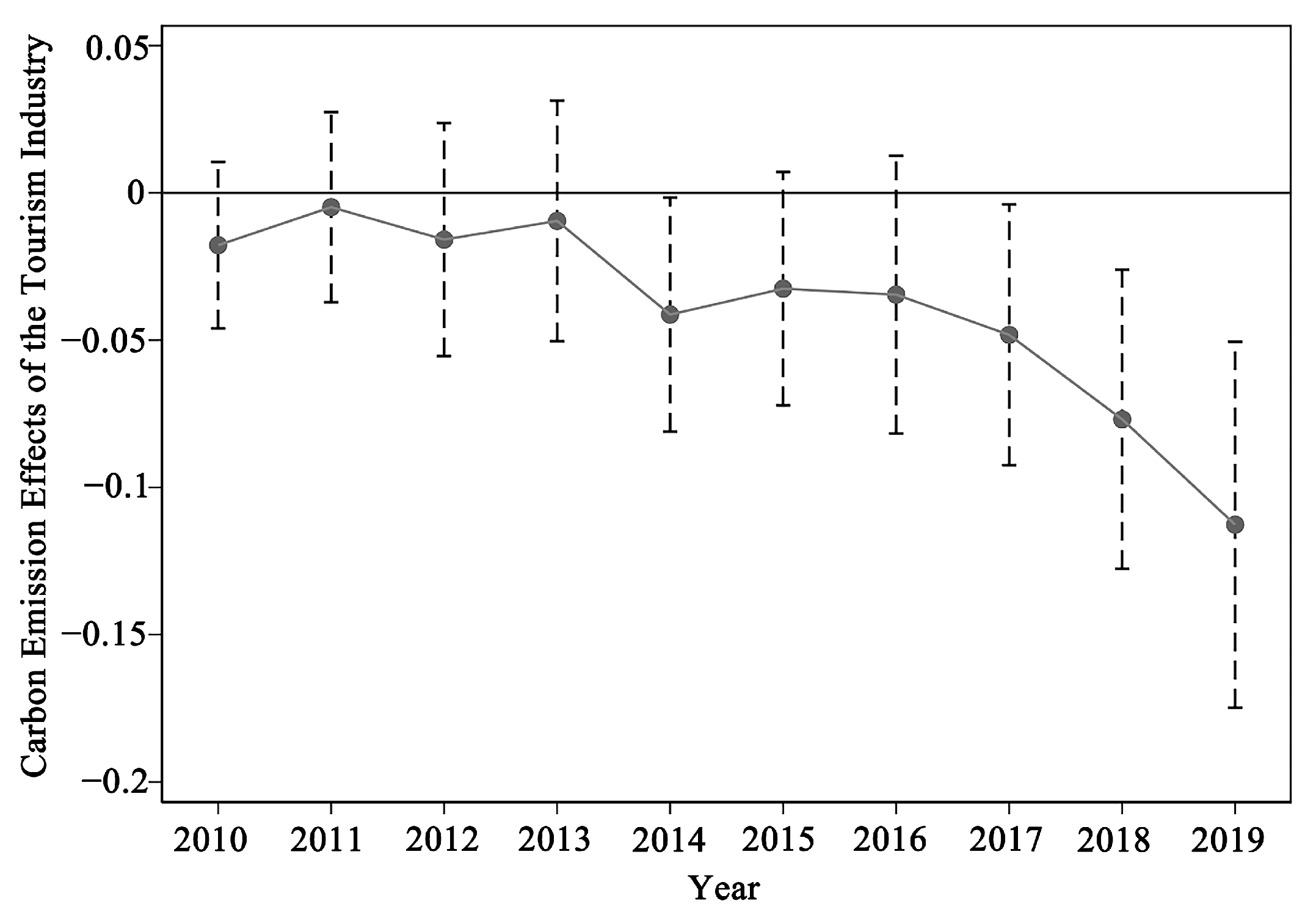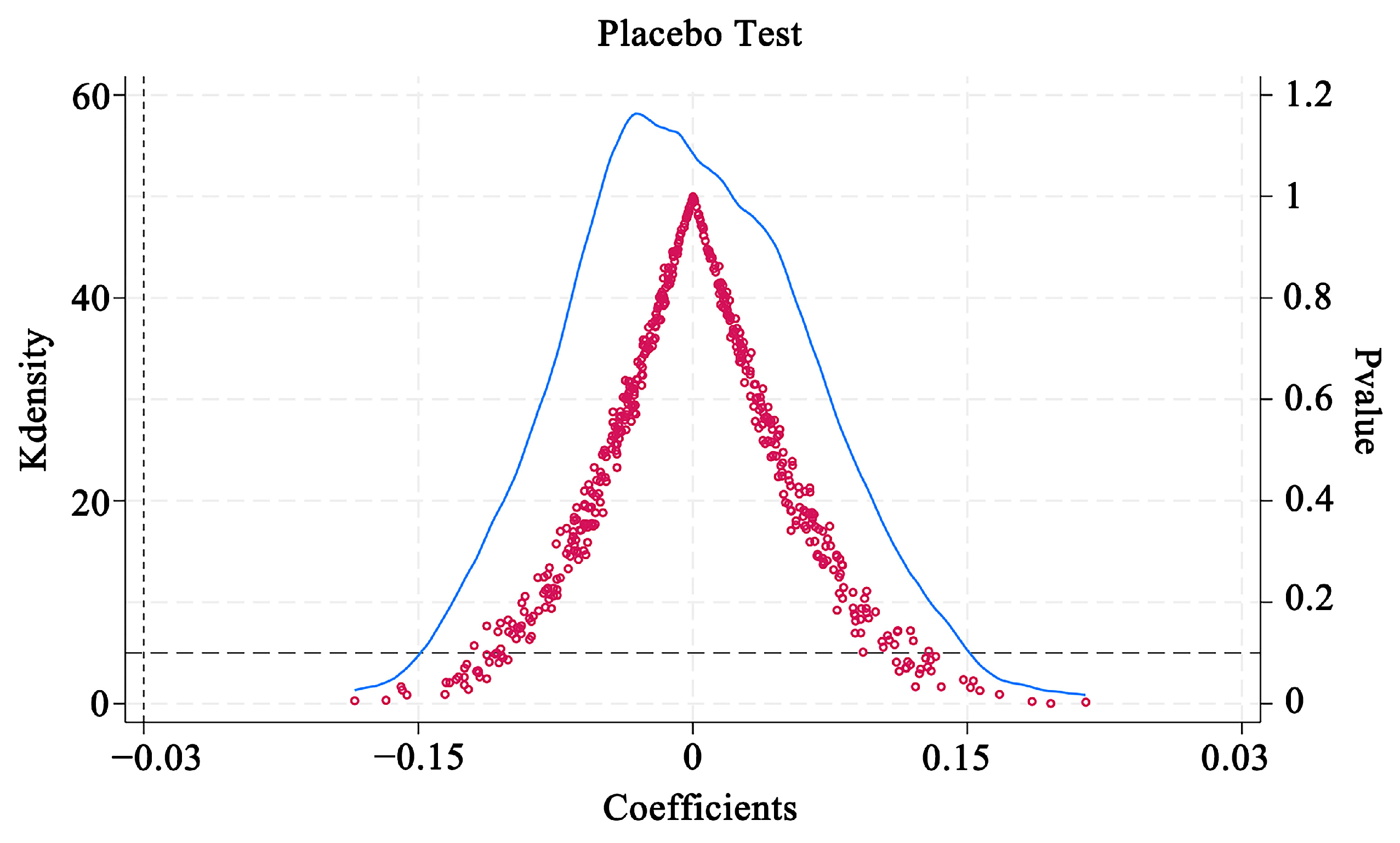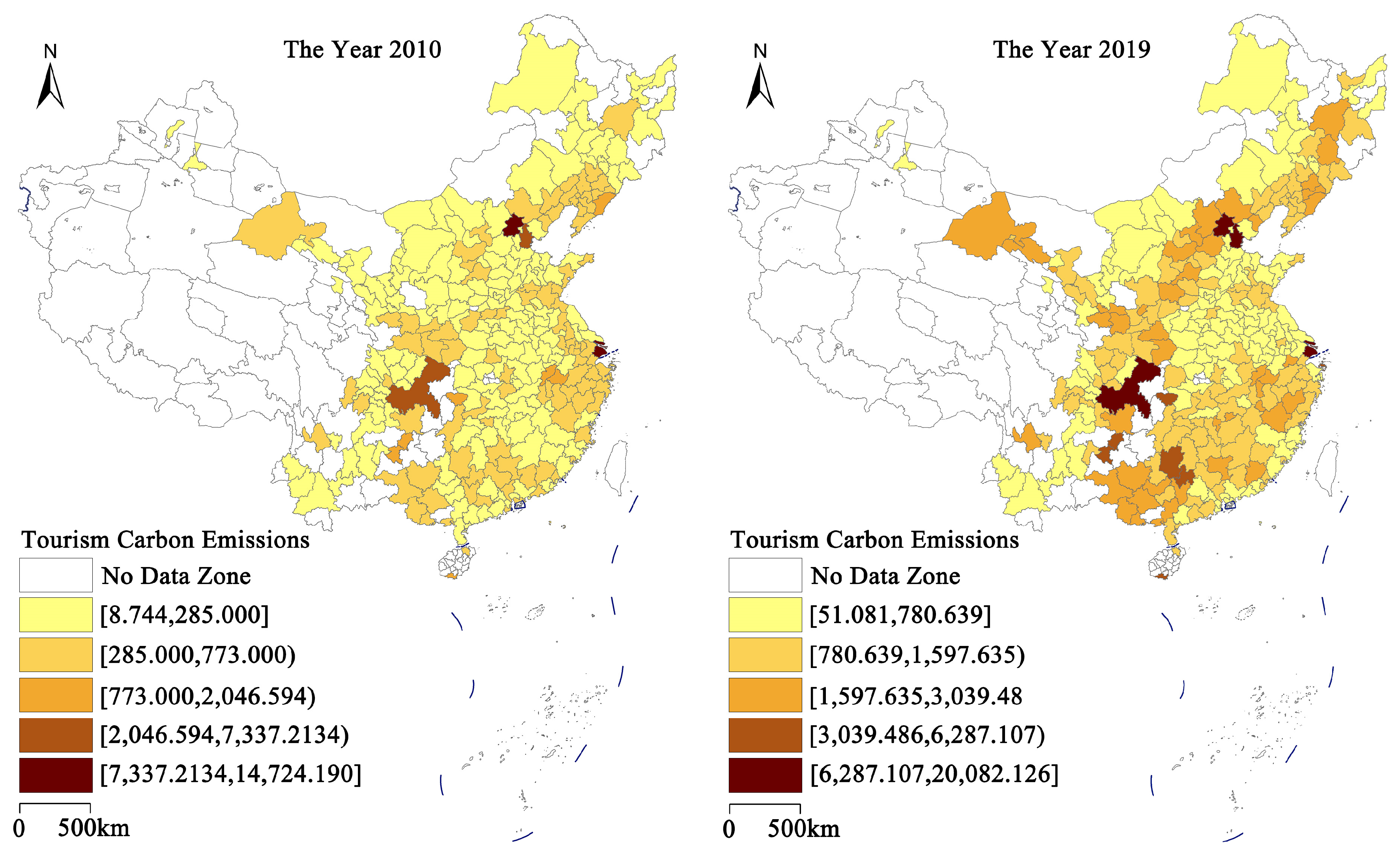Do Ecotourism Demonstration Areas Mitigate Tourism Carbon Emissions in China?—A Perspective Based on Quasi-Natural Experimentation
Abstract
:1. Introduction
2. Literature Review
3. Theoretical Mechanism and Research Hypotheses
3.1. Government–Tourism Enterprise Evolutionary Game Analysis
3.1.1. Model Assumptions
3.1.2. Model Establishment and Solution
3.2. Dynamic Evolutionary Game Analysis Between Government and Tourists
3.2.1. Model Assumptions
3.2.2. Model Establishment and Solution
3.3. Research Hypotheses
4. Research Design
4.1. Sample Selection and Data Sources
4.2. Model Setup and Variable Definitions
4.2.1. Dependent Variable
4.2.2. Key Explanatory Variable
4.2.3. Control Variables
5. Empirical Results Analysis
5.1. Baseline Regression Test
5.2. Parallel Trends Test
5.3. Robustness Test
5.3.1. Placebo Test
5.3.2. Propensity Score Matching Test
5.3.3. Excluding Policy Interference
6. Heterogeneity Test and Mechanism Analysis
6.1. Regional Heterogeneity Test
6.2. Heterogeneity Test of Resource-Based City Types
6.3. Mechanism Verification
7. Conclusions, Recommendations, and Discussion
7.1. Conclusions
7.2. Recommendations
7.3. Discussion
7.4. Limitations and Future Research Directions
Author Contributions
Funding
Data Availability Statement
Conflicts of Interest
References
- Zhao, Y.; Wang, P. The Digital Economy, R&D Investments, and CO2 Emissions: Unraveling Reduction Potentials in China. Reg. Sci. Environ. Econ. 2025, 2, 4. [Google Scholar] [CrossRef]
- Das, R.C.; Ivaldi, E. Is pollution a cost to health? Theoretical and empirical inquiry for the world’s leading polluting economies. Int. J. Environ. Res. Public Health 2021, 18, 6624. [Google Scholar] [CrossRef] [PubMed]
- Das, R.C.; Chatterjee, T.; Ivaldi, E. Sustainability of urbanization, non-agricultural output and air pollution in the world’s top 20 polluting countries. Data 2021, 6, 65. [Google Scholar] [CrossRef]
- Bluwstein, J. Creating ecotourism territories: Environmentalities in Tanzania’s community-based conservation. Geoforum 2017, 83, 101–113. [Google Scholar]
- Lee, J.H.; Choi, H.O. Stakeholders’ views on reducing financial support in government-led ecotourism areas. Ocean. Coast. Manag. 2017, 144, 7–15. [Google Scholar]
- Buckley, R.; Mossaz, A. Private conservation funding from wildlife tourism enterprises in sub-Saharan Africa: Conservation marketing beliefs and practices. Biol. Conserv. 2018, 218, 57–63. [Google Scholar]
- Bateman, P.W.; Fleming, P.A. Are negative effects of tourist activities on wildlife over-reported? A review of assessment methods and empirical results. Biol. Conserv. 2017, 211, 10–19. [Google Scholar] [CrossRef]
- Li, C.; Liu, H. On the coordinated development of ecotourism and regional economy: A case study of Poyang Lake Ecotourism Demonstration Zone in Jiangxi Province. Qius Shi. 2012, 2012, 62–65. [Google Scholar]
- Guo, T.; Wu, W.; Hu, F. A study on the spatial spillover effects of the impact of ecotourism on economic growth: Based on data from 60 key tourist cities in China. Ecol. Econ. 2023, 1, 1–18. [Google Scholar]
- Higham, J.; Cohen, S.A.; Cavaliere, C.T.; Reis, A.; Finkler, W. Climate change, tourist air travel and radical emissions reduction. J. Clean. Prod. 2016, 111, 336–347. [Google Scholar] [CrossRef]
- Tang, C.; Zhong, L.; Ng, P. Factors that influence the tourism industry’s carbon emissions: A tourism area life cycle model perspective. Energy Policy 2017, 109, 704–718. [Google Scholar]
- Ma, X.; Han, M.; Luo, J.; Song, Y.; Chen, R.; Sun, X. The empirical decomposition and peak path of China’s tourism carbon emissions. Environ. Sci. Pollut. Res. 2021, 28, 66448–66463. [Google Scholar]
- Chen, Q.; Mao, Y.; Morrison, A.M. Impacts of environmental regulations on tourism carbon emissions. Int. J. Environ. Res. Public Health 2021, 18, 12850. [Google Scholar] [CrossRef] [PubMed]
- Pan, Y.; Weng, G.; Li, C.; Li, J. Coupling coordination and influencing factors among tourism carbon emission, tourism economy and tourism innovation. Int. J. Environ. Res. Public Health 2021, 18, 1601. [Google Scholar] [PubMed]
- Liu, J.; Wang, Z.; Li, C. All-for-One Tourism Demonstration Zones and high-quality development of tourism: Evidence from the quasi-natural experiment in China. Sustainability 2023, 15, 11626. [Google Scholar] [CrossRef]
- Zhao, H.; Zhao, X.; Elahi, E.; Wang, F. Policy evaluation of drama-related intangible cultural heritage tourism for boosting green industry: An empirical analysis based on quasi-natural experiment. Sustainability 2022, 14, 5380. [Google Scholar] [CrossRef]
- Tong, Y.; Pang, L. Can ecotourism development promote residents’ environmental concern? A quasi-natural experiment from China. Curr. Issues Tour. 2023, 27, 864–872. [Google Scholar]
- Huang, X.; Song, J.; Yang, L.; Zhong, L.; Yan, K. Ecotourism certification and regional low-carbon sustainable development: A quasi-experimental study based on the prototype-zone of national ecotourism attractions in China. J. Clean. Prod. 2023, 423, 138731. [Google Scholar]
- Sun, Y.; Liu, B.; Fan, J.; Qiao, Q. The multi-player evolutionary game analysis for the protective development of ecotourism. Environ. Sci. Policy 2021, 126, 111–121. [Google Scholar]
- Zheng, S.; Kahn, M.E.; Sun, W.; Luo, D. Incentives for China’s urban mayors to mitigate pollution externalities: The role of the central government and public environmentalism. Reg. Sci. Urban Econ. 2014, 47, 61–71. [Google Scholar]
- He, P.; He, Y.; Xu, F. Evolutionary analysis of sustainable tourism. Ann. Tour. Res. 2018, 69, 76–89. [Google Scholar]
- Zhang, S.; Li, Y.; Hao, Y.; Zhang, Y. Does public opinion affect air quality? Evidence based on the monthly data of 109 prefecture-level cities in China. Energy Policy 2018, 116, 299–311. [Google Scholar]
- Aragòn-Correa, J.A.; Marcus, A.A.; Vogel, D. The effects of mandatory and voluntary regulatory pressures on firms’ environmental strategies: A review and recommendations for future research. Acad. Manag. Ann. 2020, 14, 339–365. [Google Scholar] [CrossRef]
- Kopnina, H. Neoliberalism, pluralism and environmental education: The call for radical re-orientation. Environ. Dev. 2015, 15, 120–130. [Google Scholar]
- Li, T.T.; Liu, F.; Soutar, G.N. Experiences, post-trip destination image, satisfaction and loyalty: A study in an ecotourism context. J. Mark. Manag. 2021, 19, 100547. [Google Scholar]
- Li, W.; Yi, P.; Zhang, D.; Zhou, Y. Assessment of coordinated development between social economy and ecological environment: Case study of resource-based cities in Northeastern China. Sustain. Cities Soc. 2020, 59, 102208. [Google Scholar]
- Beck, T.; Levine, R.; Levkov, A. Big bad banks? The winners and losers from bank deregulation in the United States. J. Financ. 2010, 65, 1637–1667. [Google Scholar]
- Wang, J. The economic impact of special economic zones: Evidence from Chinese municipalities. J. Dev. Econ. 2013, 101, 133–147. [Google Scholar]
- Liu, Z.; Lu, C.; Mao, J.; Sun, D.; Li, H.; Lu, C. Spatial–temporal heterogeneity and the related influencing factors of tourism efficiency in China. Sustainability 2021, 13, 5825. [Google Scholar] [CrossRef]
- Lu, C.; Liu TM, Z. Spatial-temporal evolution and its influencing factors of tourism eco-efficiency in China. J. Geogr. Res. 2022, 5, 1067835. [Google Scholar]
- Li, S.; Ren, T.; Jia, B.; Zhong, Y. The spatial pattern and spillover effect of the eco-efficiency of regional tourism from the perspective of green development: An empirical study in China. Forests 2022, 13, 1324. [Google Scholar] [CrossRef]
- Fan, F.; Song, T.; Zhai, X. Education, science and technology, and talent integrated development: Evidence from China. Reg. Sci. Environ. Econ. 2024, 1, 60–77. [Google Scholar] [CrossRef]
- Chetty, R.; Looney, A.; Kroft, K. Salience and taxation: Theory and evidence. Am. Econ. Rev. 2009, 99, 1145–1177. [Google Scholar]
- Ferrara, E.L.; Chong, A.; Duryea, S. Soap operas and fertility: Evidence from Brazil. Am. Econ.J. Appl. Econ. 2012, 4, 1–31. [Google Scholar]
- Xu, E.; Xiao, Z.; Wang, Z. Has the pilot project of innovative cities increased economic growth? An empirical study based on Chinese cities. Reg. Sci. Environ. Econ. 2024, 1, 31–45. [Google Scholar] [CrossRef]
- Huo, W.; Qi, J.; Yang, T.; Liu, J.; Liu, M.; Zhou, Z. Effects of China’s pilot low-carbon city policy on carbon emission reduction: A quasi-natural experiment based on satellite data. Technol. Forecast. Soc. Change 2022, 175, 121422. [Google Scholar] [CrossRef]
- Witte, J.C.; Schoeberl, M.R.; Douglass, A.R.; Gleason, J.F.; Krotkov, N.A.; Gille, J.C.; Pickering, K.E.; Livesey, N. Satellite observations of changes in air quality during the 2008 Beijing Olympics and Paralympics. Geophys. Res. Lett. 2009, 36, 17. [Google Scholar]




| Strategic Choice | Tourism Enterprises | ||
|---|---|---|---|
| Control x | Not Control 1 − x | ||
| Government | Supervision y | L − K − A + W, D1 + A | S − K − A + W + F1, D2 + A − F1 |
| No supervision 1 − y | L − P1, D1 | S − P1, D2 | |
| Equilibrium Point | Eigenvalue | Symbol | Stability |
|---|---|---|---|
| (0, 0) | σ1 = D1 − D2 σ2 = F1 − A − K + P1+W | σ1 > 0 σ2 > 0 | Not stable |
| (1, 0) | σ1 = D2 − D1 σ2 = P1 − K − A + W | σ1 < 0 σ2 > 0 | Not stable |
| (0, 1) | σ1 = D1 − D2 + F1 σ2 = A − F1 + K − P1 − W | σ1 > 0 σ2 < 0 | Not stable |
| (1, 1) | σ1 = D2 − D1 − F1 σ2 = A + K − P1 − W | σ1 < 0 σ2 < 0 | Stable |
| Strategic Choice | Tourists | ||
|---|---|---|---|
| Choosing x | Not Choosing 1 − x | ||
| Government | Investing y | L − M + W, R1 − C | S + W + R3 − M, R1 + R2 − R3 |
| Not investing 1 − y | L − P1, −C | S − P1, R3 | |
| Equilibrium Point | Eigenvalue | Symbol | Stability |
|---|---|---|---|
| (0, 0) | σ1 = −C − R2 σ2 = P1 − M + R3 + W | σ1 < 0 σ2 > 0 | Not stable |
| (1, 0) | σ1 = C + R2 σ2 = P1 − M + W | σ1 > 0 σ2 > 0 | Not stable |
| (0, 1) | σ1 = R3 − R2 − C σ2 = M − P1 − R3 − W | σ1 > 0 σ2 < 0 | Not stable |
| (1, 1) | σ1 = C + R2 − R3 σ2 = M − P1 − W | σ1 < 0 σ2 < 0 | Stable |
| Category | Title | Obs. | Mean | Std. Dev. | Min | Max |
|---|---|---|---|---|---|---|
| Dependent Variable | LTCE | 2760 | 6.018 | 0.982 | 3.444 | 9.215 |
| Core Explanatory Variable | City × Year | 2760 | 0.155 | 0.362 | 0 | 1 |
| Control Variable | LREL | 2760 | 12 | 1.064 | 8.424 | 16.246 |
| Lpgdp | 2760 | 10.663 | 0.590 | 8.576 | 12.579 | |
| LTSE | 2760 | 5.331 | 1.172 | 0.811 | 8.736 | |
| TE | 2760 | 0.228 | 7.094 | 0.003 | 372.742 | |
| ISE | 2760 | 40.548 | 9.999 | 9.76 | 83.52 | |
| LEL | 2760 | 14.812 | 0.768 | 11.711 | 18.241 | |
| LTSL | 2760 | 7.417 | 1.072 | −0.354 | 11.178 |
| Control Variable | VIF | 1/VIF |
|---|---|---|
| LREL | 4.25 | 0.235 |
| Lpgdp | 1.85 | 0.542 |
| LTSE | 3.62 | 0.277 |
| TE | 1.00 | 0.999 |
| ISE | 1.75 | 0.572 |
| LEL | 4.29 | 0.233 |
| LPSL | 1.96 | 0.509 |
| Mean VIF | 2.67 | |
| Variable | (1) | (2) |
|---|---|---|
| LTCE | LTCE | |
| City × Year | −0.078 * (0.046) | −0.03 ** (0.014) |
| LREL | −0.025 ** (0.01) | |
| Lpgdp | −0.657 *** (0.057) | |
| LTSE | 0.941 *** (0.016) | |
| TE | 0.008 *** (0) | |
| ISE | 0.006 *** (0.001) | |
| LEL | −0.088 ** (0.039) | |
| LTSL | −0.009 (0.01) | |
| Constant | 5.368 *** (0.019) | 9.369 *** (0.518) |
| City Fixed Effect | Control | Control |
| Year Fixed Effect | Control | Control |
| N | 2760 | 2760 |
| R2 | 0.756 | 0.953 |
| Variable | (1) | (2) |
|---|---|---|
| LTCE (Two Years in Advance) | LTCE (Three Years in Advance) | |
| City × Year | −0.019 (0.015) | −0.024 (0.019) |
| Constant | 9.37 *** (0.521) | 9.383 *** (0.519) |
| Control Variable | Control | Control |
| City Fixed Effect | Control | Control |
| Year Fixed Effect | Control | Control |
| N | 2760 | 2760 |
| R2 | 0.953 | 0.953 |
| Variable | LTCE |
|---|---|
| City × Year | −0.036 * (0.02) |
| Constant | 8.295 *** (0.65) |
| Control Variable | Control |
| City Fixed Effect | Control |
| Year Fixed Effect | Control |
| N | 1317 |
| R2 | 0.937 |
| Variable | LTCE |
|---|---|
| City × Year | −0.029 ** (0.014) |
| Low-Carbon Pilot Cities | −0.003 (0.01) |
| Constant | 9.371 *** (0.518) |
| Control Variable | Control |
| City Fixed Effect | Control |
| Year Fixed Effect | Control |
| N | 2760 |
| R2 | 0.953 |
| Variable | (1) | (2) | (3) |
|---|---|---|---|
| LTCE (Eastern) | LTCE (Central) | LTCE (Western) | |
| City × Year | −0.053 *** (0.018) | 0.01 (0.02) | −0.035 (0.027) |
| Constant | 8.719 *** (1.129) | 10.337 *** (0.975) | 8.072 *** (0.758) |
| Control Variable | Control | Control | Control |
| City Fixed Effect | Control | Control | Control |
| Year Fixed Effect | Control | Control | Control |
| N | 1000 | 950 | 810 |
| R2 | 0.961 | 0.962 | 0.948 |
| Variable | (1) | (2) | (3) | (4) | (5) |
|---|---|---|---|---|---|
| LTCE Growth Oriented | LTCE Mature Oriented | LTCE Decline Oriented | LTCE Regeneration Oriented | LTCE Non-Resource Based | |
| City × Year | −0.105 *** (0.032) | 0.007 (0.0334) | −0.147 * (0.084) | 0.007 (0.065) | −0.03 * (0.016) |
| Constant | 1.757 (4.356) | 10.36 *** (0.613) | 11.619 *** (1.636) | 12.191 *** (1.772) | 8.211 *** (0.845) |
| Control Variable | Control | Control | Control | Control | Control |
| City Fixed Effect | Control | Control | Control | Control | Control |
| Year Fixed Effect | Control | Control | Control | Control | Control |
| N | 120 | 600 | 200 | 140 | 1700 |
| R2 | 0.955 | 0.964 | 0.948 | 0.961 | 0.953 |
| Variable | (1) | (2) | (3) |
|---|---|---|---|
| Hotel Scale | Environmental Regulation | Low-Carbon Tourism Investment | |
| City × Year | −5.618 ** (2.181) | 0.12 ** (0.052) | 124.106 *** (46.33) |
| Constant | 74.556 * (43.016) | 1.483 (1.857) | −7899.024 *** (1081.812) |
| Control Variable | Control | Control | Control |
| City Fixed Effect | Control | Control | Control |
| Year Fixed Effect | Control | Control | Control |
| N | 2760 | 2760 | 2760 |
| R2 | 0.261 | 0.186 | 0.999 |
Disclaimer/Publisher’s Note: The statements, opinions and data contained in all publications are solely those of the individual author(s) and contributor(s) and not of MDPI and/or the editor(s). MDPI and/or the editor(s) disclaim responsibility for any injury to people or property resulting from any ideas, methods, instructions or products referred to in the content. |
© 2025 by the authors. Licensee MDPI, Basel, Switzerland. This article is an open access article distributed under the terms and conditions of the Creative Commons Attribution (CC BY) license (https://creativecommons.org/licenses/by/4.0/).
Share and Cite
Quan, S.; Wang, F. Do Ecotourism Demonstration Areas Mitigate Tourism Carbon Emissions in China?—A Perspective Based on Quasi-Natural Experimentation. Reg. Sci. Environ. Econ. 2025, 2, 9. https://doi.org/10.3390/rsee2020009
Quan S, Wang F. Do Ecotourism Demonstration Areas Mitigate Tourism Carbon Emissions in China?—A Perspective Based on Quasi-Natural Experimentation. Regional Science and Environmental Economics. 2025; 2(2):9. https://doi.org/10.3390/rsee2020009
Chicago/Turabian StyleQuan, Shanxin, and Feng Wang. 2025. "Do Ecotourism Demonstration Areas Mitigate Tourism Carbon Emissions in China?—A Perspective Based on Quasi-Natural Experimentation" Regional Science and Environmental Economics 2, no. 2: 9. https://doi.org/10.3390/rsee2020009
APA StyleQuan, S., & Wang, F. (2025). Do Ecotourism Demonstration Areas Mitigate Tourism Carbon Emissions in China?—A Perspective Based on Quasi-Natural Experimentation. Regional Science and Environmental Economics, 2(2), 9. https://doi.org/10.3390/rsee2020009





